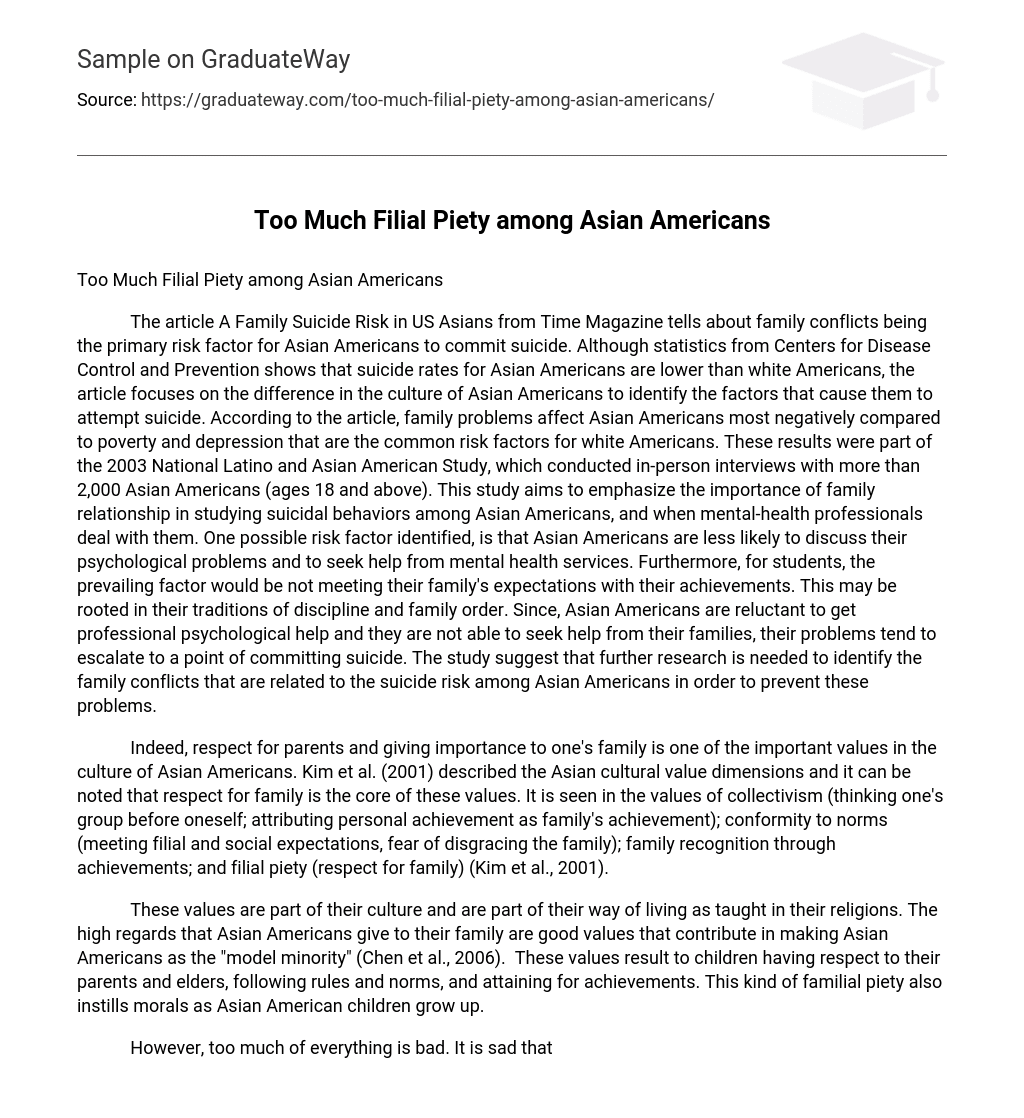The article A Family Suicide Risk in US Asians from Time Magazine tells about family conflicts being the primary risk factor for Asian Americans to commit suicide. Although statistics from Centers for Disease Control and Prevention shows that suicide rates for Asian Americans are lower than white Americans, the article focuses on the difference in the culture of Asian Americans to identify the factors that cause them to attempt suicide. According to the article, family problems affect Asian Americans most negatively compared to poverty and depression that are the common risk factors for white Americans. These results were part of the 2003 National Latino and Asian American Study, which conducted in-person interviews with more than 2,000 Asian Americans (ages 18 and above). This study aims to emphasize the importance of family relationship in studying suicidal behaviors among Asian Americans, and when mental-health professionals deal with them. One possible risk factor identified, is that Asian Americans are less likely to discuss their psychological problems and to seek help from mental health services. Furthermore, for students, the prevailing factor would be not meeting their family’s expectations with their achievements. This may be rooted in their traditions of discipline and family order. Since, Asian Americans are reluctant to get professional psychological help and they are not able to seek help from their families, their problems tend to escalate to a point of committing suicide. The study suggest that further research is needed to identify the family conflicts that are related to the suicide risk among Asian Americans in order to prevent these problems.
Indeed, respect for parents and giving importance to one’s family is one of the important values in the culture of Asian Americans. Kim et al. (2001) described the Asian cultural value dimensions and it can be noted that respect for family is the core of these values. It is seen in the values of collectivism (thinking one’s group before oneself; attributing personal achievement as family’s achievement); conformity to norms (meeting filial and social expectations, fear of disgracing the family); family recognition through achievements; and filial piety (respect for family) (Kim et al., 2001).
These values are part of their culture and are part of their way of living as taught in their religions. The high regards that Asian Americans give to their family are good values that contribute in making Asian Americans as the “model minority” (Chen et al., 2006). These values result to children having respect to their parents and elders, following rules and norms, and attaining for achievements. This kind of familial piety also instills morals as Asian American children grow up.
However, too much of everything is bad. It is sad that while in white Americans and African Americans cultures, there is an increasing problem with children lacking respect towards their parents, in Asian Americans, it is too much filial piety that seems to be the problem. Asian Americans are the fastest growing ethnic minority group in the U.S. according to Kim et al. (2001). The change in society for the Asian Americans, the fast-paced and relatively higher levels of education could have caused students more difficulty in their studies that could result to serious problems when they fail to meet their parent’s expectations.
The difference in values and cultures among racial groups in America should be a concern of psychologist. According to the study of Weisz et al. (2006), “it is not appropriate to use U.S-derived syndromes as a standard for diverse adolescent populations…” This means that psychopathology among youth differs among culture. In addition, studying the risk factors for Asian American should be different from other ethnic groups. Also, it is important to take note that in giving psychological help with Asian Americans, it is important not to stereotype all Asians, meaning different Asian racial groups have different cultures and values towards family relationship. The differences in the Asian groups should also be noted and considered in studying the suicide risk of Asian Americans.
References
Chen, G.A., Lephuoc, P., Guzman, M.R., Rude, S.S., ; Dodd, B.G. Exploring Asian American racial identity. Cultural Diversity and Ethnic Minority Psychology, 12(3), 461-476.
Hylton H. (2008).(2008, August 19). A Family Suicide Risk in US Asians?. TIME Magazine. Retrieved May 3, 2009, from http://www.time.com/time/health/article/0,8599,1833971,00.html
Kim, B.S.K., Yang, P.H., Atkinson, D.R., Wolfe, M.M. ; Hong, S. (2001). Cultural value similarities and differences among Asian American ethnic groups. Cultural Diversity and Mental Health, 7(4), 343-361.
Weisz, J.R., Weiss, B., Suwanlert, S., Chaiyasit, W. Culture and youth psychopatholgy: Testing the syndromal sensitivity model and Thai and American adolescents. Journal of Consulting and Clinical Psychology, 74 (6),1098-1107.





